Review by Chris Rennirt
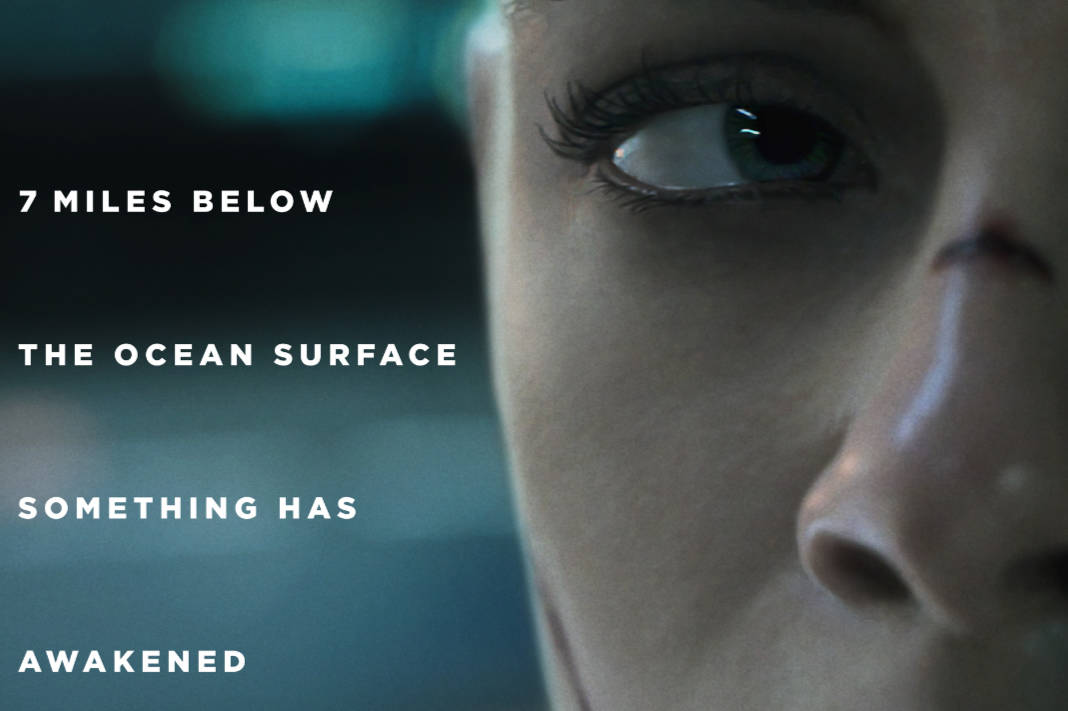
What would it be like to work on a drilling station in the Mariana Trench, seven miles below the ocean surface, in the deepest place on Earth? Or worse, what would it be like to work there when the station experiences structural failure, with 15,750 pounds of force per square inch ready to crush you, instantly. Can it get worse? Believe it or not, yes! A lot worse! “Something has awakened” there! But what? Six oceanic researchers are about to find out, in the latest sci-fi thriller Underwater, from director William Eubank, and writers Brian Duffield and Adam Cozad.
As a bonus for the impatient, Underwater wastes no time submerging us in the depths of its action and mystery. Beginning with peace and quiet in front of a restroom mirror, even taking time to show a stowaway spider helped from a sink by the main character Norah (Kristen Stewart), we know something loud and horrible is about to happen. Of course! It’s all too silent for this type of movie. Sure enough, shaking, seemingly from an earthquake, followed by drips from the ceiling, are harbingers of doom on cue. Like in a video game, we are propelled forward, relentlessly, with little respite, until the movie’s end. 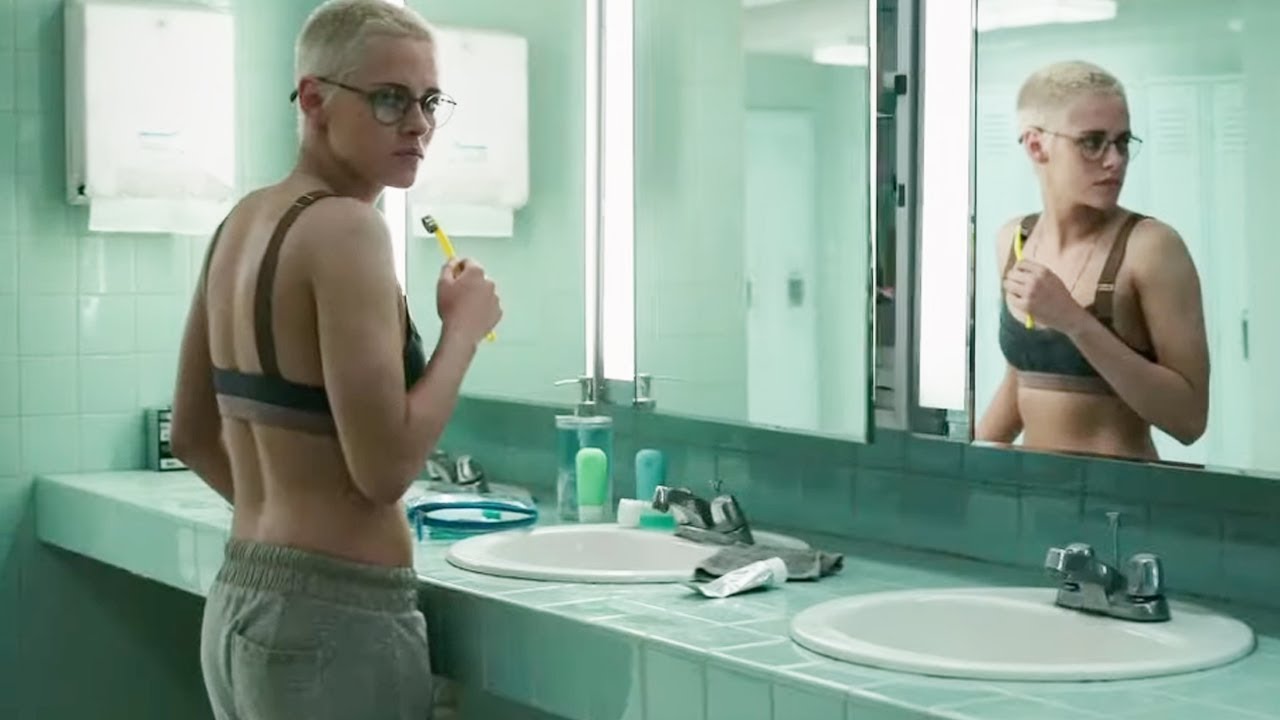
Kristen Stewart is perfectly cast as Norah – a mechanic and technical guru of the underwater drilling facility Kepler 822. If there’s a way to fix it, she has it done, as fast as any sci-fi captain could want; even Captain Kirk could use a Norah onboard the Enterprise. Yes! She’s just who we expect to save the day, for all six trying to escape. But, is she? “There’s comfort to cynicism. There’s a lot less to lose,” she thinks to herself in the film’s beginning. “Can you just admit we might die?” she says, adding more pessimism to her character. Can a cynic be so heroic; to be a hero, selflessly, for others; to take such risk at losing more? Will Norah be the hero we expect? As Captain Lucien asks Norah, “Can you just admit we might live?”
“This better not be some 20,000 Leagues Under the Sea shit.” ~ Paul Abel
I admit that I have not seen any of Stewart’s previous movies. (Yes! Believe it or not, it’s true!) I know of her mostly as a character in the Twilight series – a series I also know nothing about. However, after seeing Stewart’s performance in Underwater, I am highly impressed! Outstanding for sure is her ability to change emotions on cue and convincingly, as scenes require – especially in a movie that changes such requirements in an instant. What’s more is that Stewart has invested herself, utterly, in her character. Without having an actor “in-the-soul” of Norah, as Stewart is, Underwater wouldn’t have half its depth and impact. Instead, it might float in the sea of mediocrity, as another example of B-grade sci-fi forgettables.

Kristen Stewart as Norah
Watching one of the many behind-the-scenes featurettes, I learned that Stewart insisted on adding even more realism to her character and events, in ways that others would overlook. In the featurette, the director talks about how Stewart wanted to run barefoot through the hallway tunnel in the movie’s beginning, adding, visually, to the reality being unprepared in the moment’s suddenness. Yes! Instead of having all the shit hit the fan, conveniently after the actor puts her shoes on, go ahead and let it rip while she’s still barefoot! Although Stewart running barefoot in the scene posed some safety issues, the director found a way to pull it off anyway (watch the featurette to see how they do it). I love those extra touches of realism, and, thanks to out-of-the box (or out-of-the-shoe) thinkers like Stewart, we get just that – an actress who goes barefoot when the others wear shoes…and a whole lot more!
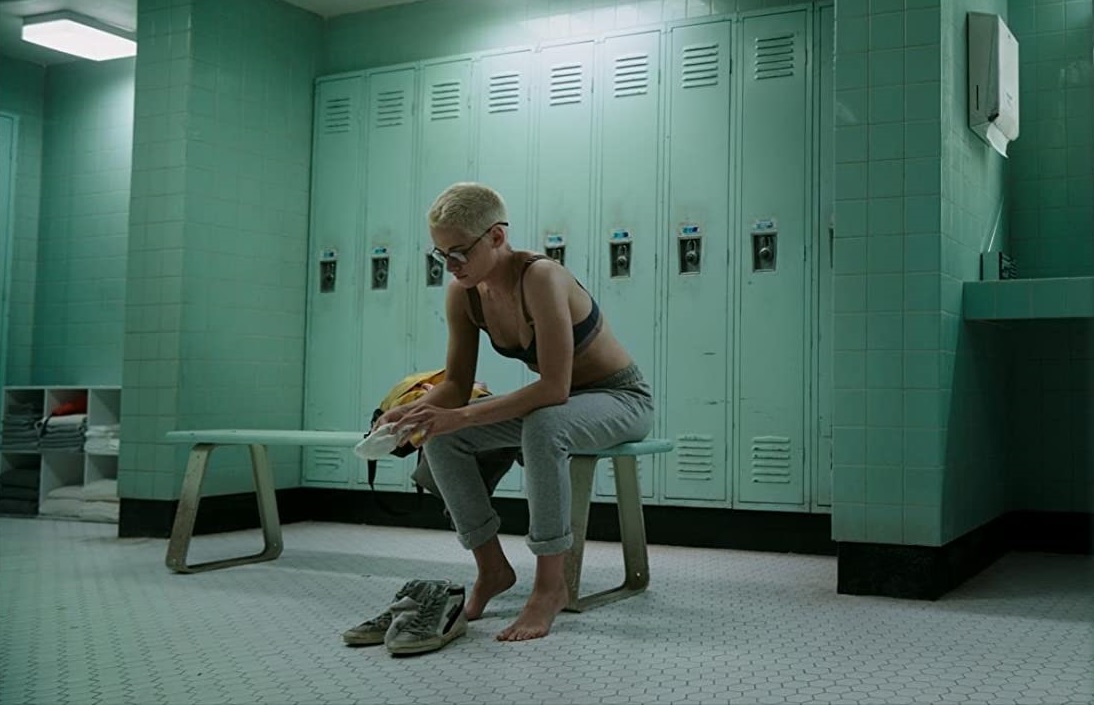
Yes! What a great idea it is to keep those shoes off, Kristen!
Emily Haversham (Jessica Henwick) is the resident biologist, easily the most scared of the six. Being emotionally fragile, she adds a needed element of vulnerability, tapping into fears most of us have in horrifying circumstances. As viewers on a sofa, in the safety of our own homes, we need Emily to remind us who we are, as humans. Her stamina, however, comes as a refreshing contrast to typical characters who are little more than frightened fodder for the body count. With Jessica Henwick’s skills as an actor, the purest elements of hope and love are added, as a contrast to Norah’s pessimism and belief in human selfishness. Henwick elevates what could have been a secondary character to one of primary importance; in doing so, she elevates Underwater fathoms higher. In a deleted scene, the “cynical” Norah actually shed’s a tear upon hearing Emily tell Liam how much she loves him. Henwick speaks with passion we believe, making the moment outstanding. Even with danger all around, we let down our guard, as viewers, to listen and think. While deleting the scene created better pacing, eliminated also was a transformative moment for Norah, and a more cerebral element in the film. This was a connection to Norah’s thoughts in the film’s beginning that was sadly lost. But, there’s a great thing about watching great deleted scenes. In the end, we remember them as part of the story anyway!

“We drilled to the bottom of the ocean, and we don’t know what came up,” says Emily
Paul Abel (actor T.J. Miller) adds an effective and needed comedic relief, with a style that seems effortless and part of his personality. His habit of cracking corny jokes and inserting humor at inappropriate moments, with just the right class-clown charm, helps us let down our guard, at just the right time, heightening the shock of tragedy ahead. A comment about the benefits of being slender, for example, is perfectly ironic and well delivered, making us laugh…even at death! It is because of the character Miller cultivates genuinely, early on, that his humor is so effective, not just at making us laugh, but all the more at making us afraid.
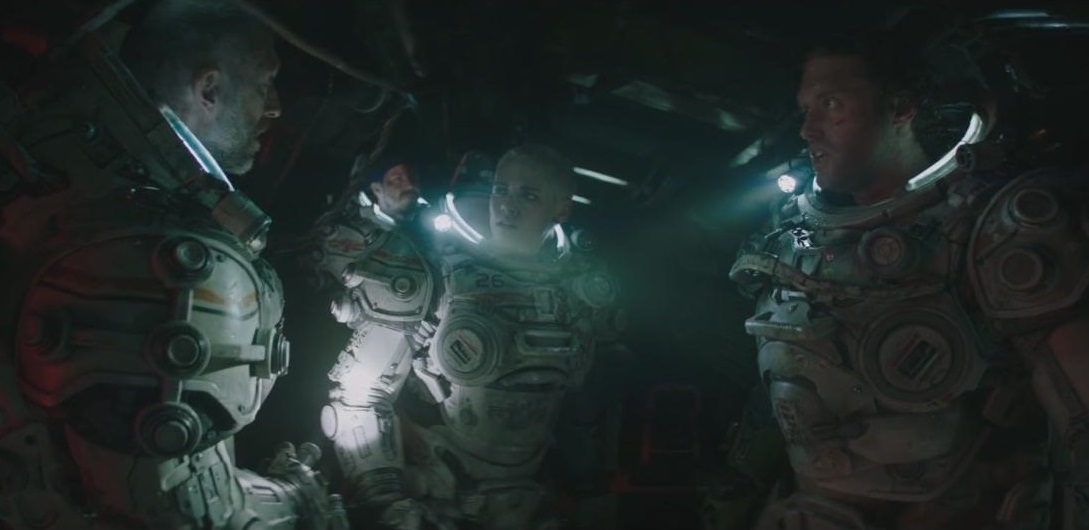
“So we’ll walk a mile in the dark, where we can’t see where we’re going, with insufficient oxygen?” ~ Paul Ablel
Digital creature effects are realistic throughout, with one practical effects scene of a captured baby adding a needed visceral touch. According to the director (as revealed in a featurette), the creatures are never revealed too much, in order to let the viewers more effectively fill in the blanks with their mind. And all the better that it is following the Hitchcock concept of “less is better.” According to the director, viewers will create, in their own minds, whatever is most frightening for them. And, with everything occurring seven miles below the ocean surface, with only human-launched flares for light, it’s going to be really damn dark anyway! What glimpses we get show us Lovecraft-style, deep-sea monsters, looking like a cross between Cthulu and a giant octopus or squid. Others look humanoid in form, somewhat, but scary as shit nonetheless!
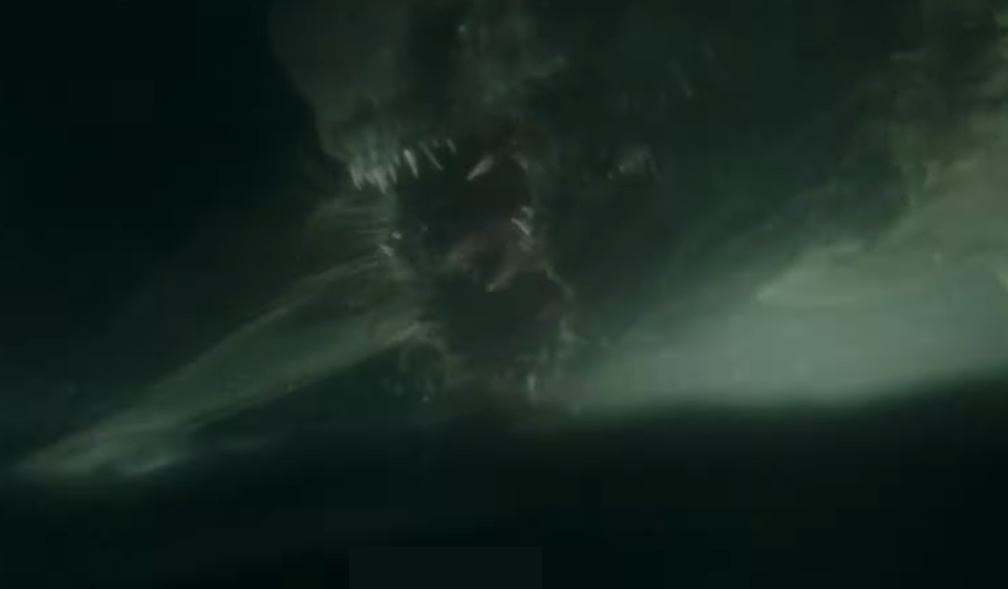
Yes! Less is always better, in the movie as much as the review!
Speaking of special effects, also interesting is the way a “dry/wet” environment is created in the making of Underwater. Before I watched the behind-the-scenes featurettes (and before I realized how difficult actual underwater filming would be), I believed the the actors were really underwater. Yes! Without really thinking about it, just letting the film “suspend my disbelief,” I never once thought the ocean was dry. So, you guessed it! The water effects were not only digital, but most amazingly digital. Great care was taken to simulate the murkiness of the water, the particles in the water, and the way water affects humans walking in it. (Harnesses were places on actors to simulate the way water pulls and restricts the movement of the body, etc.) The end results are underwater special effects, both digital and practical, that fool the mind, impressing, most likely, even Poseidon himself! A bit of a hyperbole, I know. But, it does sound good.

“Can you just admit we might die?” “Can you just admit we might live?” says Captain Lucien.
Claustrophobic effects are created with great realism (if not hyperbole). Close-ups inside the helmets of diving suits, with narrow shots in tunnels and drilling-station interiors, are just what’s needed, adding an extra, more familiar sense of pressure to the Underwater world. The tightness of spaces, visually, helps us feel the pressure, where the abstract concept fails. Yes! For those who fear tight spaces, (and for those unable to imagine 15,750 pounds of force per square inch ready to crush), you’re in luck!
Special effects featurettes included with the bluray and digital copies are well worth watching, as you, no doubt, already assume from so many such examples I’ve included. Yes! I highly recommend watching them all. Rather than being ridiculously short pieces, more like promotional material or fluff, these are lengthy and informative, taking you far deeper Underwater.
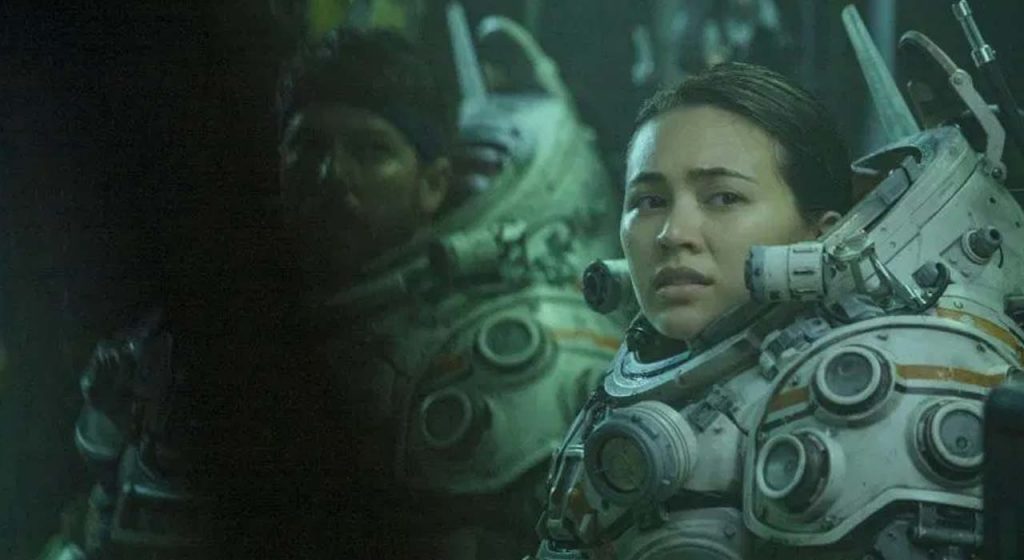
Emily Haversham (Jessica Henwick) in a pressurized suit, dreading a walk across the ocean floor.
Underwater has an effective timelessness about it. Nothing tells us the year, the decade, or even the century in which it occurs. For all we know, it could be a time in an alternate reality. The ocean-floor drilling facility alone, in all of its massive complexity, is unlike anything we can create today, at such depths. Yet, inside the facility, technology, hardware, and structure suggest a time that is oddly retro. Computer screens, monitors, and equipment look more industrial and functional than than stylishly futuristic. Is this all sounding like another, already iconic, sci-fi classic we know? Of course! Alien! Even the baby sea alien is reminiscent of something Giger himself might have designed for Ridley Scott. As for Norah being akin to Ellen Ripley, I’ll give Underwater the benefit of the doubt; can any female heroine ever again be original after Ellen? Can any great horror or sci-fi film not remind of us of the great ones already made? To Paul Abel who says, ironically, “This better not be some 20,000 Leagues Under the Sea shit,” I say, “Not exactly…but you said it first, not me.” Even with Jules Verne and Giger in mind, Underwater has fathoms of originality, achieving distinguished depths of difference.
Emily Haversham: I’ve never seen somebody die before.
Paul Abel: I’ve seen someone die. I’ve never seen anyone implode.
While Underwater‘s end may, at first, seem vague and unfulfilling, patience and analysis reveal something deeper and uniquely meaningful. Yes! Exactly what it is may be more personal than objective. With a bit of thought (yes, actually turning on your brain to think), an initial “What the f**k!” moment gives way to something that not only makes sense, but connects logically to Norah’s thinking in the movie’s beginning. For me, the end is a final, ironic moment of “comfort,” totally without “cynicism,” and utterly selfless. It is a metamorphic moment for Norah that puts her at peace, utterly, when chaos is all around her. Yes! It is possibly the end that elevates Underwater above the sea level of ordinary action films. It makes us think after the credits roll. In thinking, we find something meaningful and, perhaps, like Norah, even something comfortable.
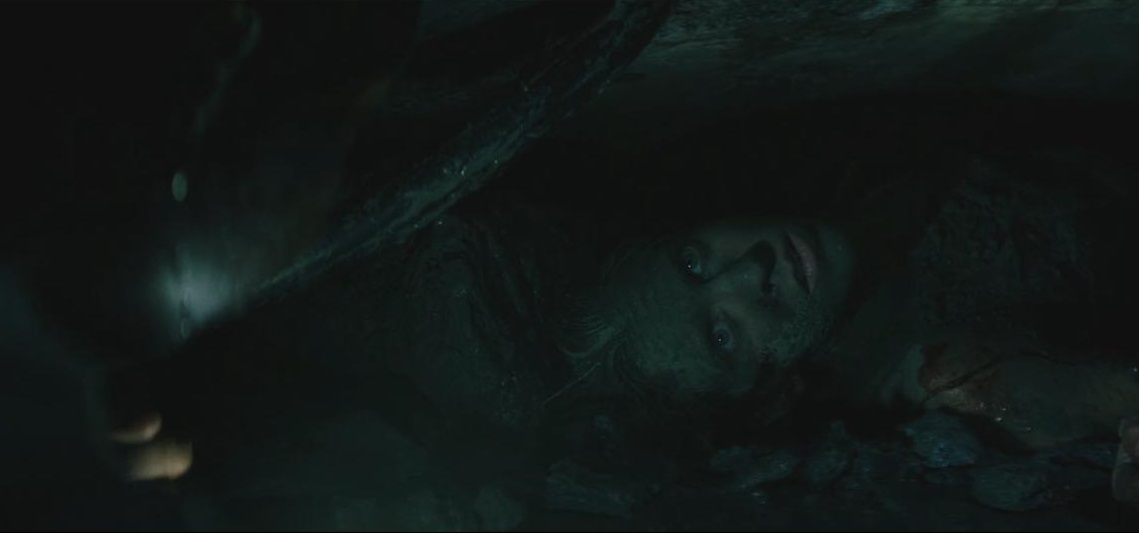
Claustrophobic? Oh yeah!
If there’s anything that bothered me about Underwater, it’s with the camera action. At times, I didn’t know what the hell was going on, even after stopping and rewatching a scene several times. In some cases, it’s actually impossible to know, based on what we are shown. While I appreciate using tight camera angles for a claustrophobic effect, I also wanted to know what was happening. But, perhaps, in wanting to know, I’m missing the point. Experiencing it all, as the characters do, makes confusion, possibly, just what the director ordered.
As for the origins of the creatures underwater, I’ve heard complaints. “What are these things, and where the hell did they come from?” some say. Who cares! And how “the hell” would the characters know anyway? Does anyone want, really, a tacked-on narration explaining it, a contrived discovery, or anything else that slows it down? Do these people have time to research anything anyway? Hell no! They really don’t have time to save their lives!
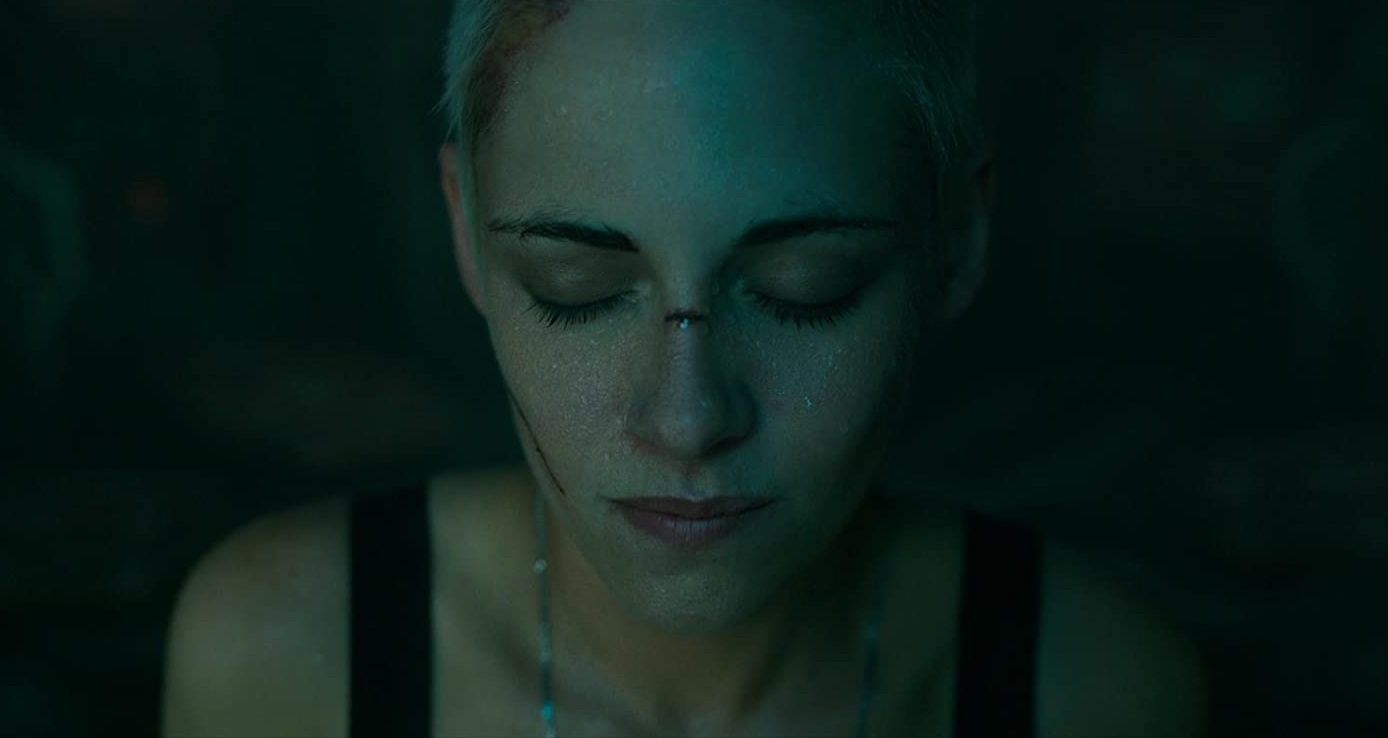
Is Norah (Kristen Stewart) enjoying a comfortable moment without cynicism? Perhaps!
With revealing more, worst of all is taking away the mystery? This is not a movie that needs to reveal the origins of its monsters. It’s a movie that carries us along, with the confusion, as if we are characters too, knowing nothing, with no time to find out. And that, I say, is another charm that makes Underwater better, consistent with the idea that “less is more.” Think of the mystery we loved about the Space Jockey, frozen and fossilized in his Space Jockey chair, along with the alien we knew nothing about. I, for one, was happier wondering, loving the mystery.
Underwater, while not original in all its content, is a movie that does the job it sets out to do. Borrowing intentionally or not from other films, it packs enough thrills, mystery, horror, and deep-sea scares to make it well worth the time. With action from beginning to end, there’s rarely a moment to be bored anyway, let alone think about anything similar you’ve seen. All of this, along with Kristen Stewart as Norah, easily keeps Underwater above the waves of sci-fi stereotypes, far from sinking to the depths.

Rocket Rating – 8
Chris Rennirt (the author of this review) is a movie critic and writer in Louisville, Kentucky, as well as editor in chief at Space Jockey Reviews. He has been a judge at many film festivals, including Macabre Faire Film Festival and Crimson Screen Film Fest, and he attends horror and sci-fi conventions often. Chris’ movie reviews, articles, and interviews are published regularly on Space Jockey Reviews and in Effective Magazine. His mission statement (describing his goals as a movie critic and philosophy for review writing) can be found on the “Mission” page, here at SJR. For more information about Chris Rennirt (including contact details, publicity photos, and more), click here.
You may also like these!









